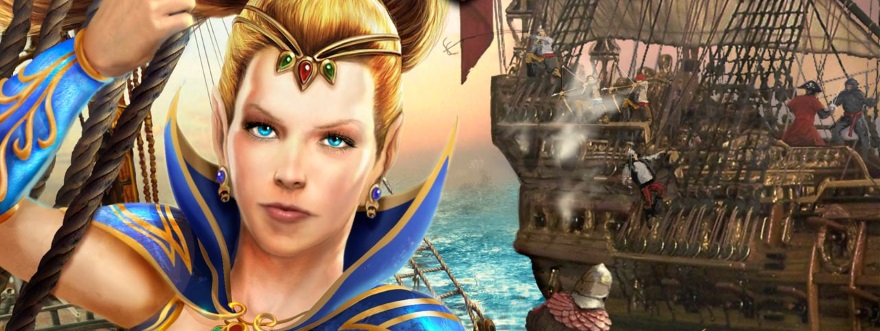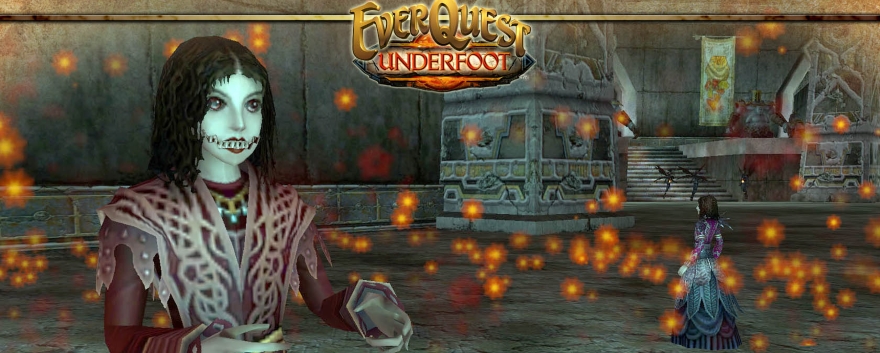
I don’t know if EverQuest holds the crown title for the MMO with the most expansions, but I’m sure it’s among the top three if not at the number one spot on that list. It’s astounding to count them up and realize that two dozen expansions have come out for that game between 2000 and 2017. That averages to a little more than one per year!
Today I want to pay tribute to the 24 expansions of EverQuest by going through them, one by one, and seeing how they grew and enriched the game over the past decade-and-a-half. I would also love to hear testimonies in the comments as to which EverQuest expansion you enjoyed the most!

1. The Ruins of Kunark (April 2000, Metascore: 86)
It was a little over a year since EverQuest’s launch before the first expansion landed, but when it did, it added to the game significantly. The Ruins of Kunark introduced 26 zones of the newly discovered continent of Kunark, raised the level cap to 60, and make the lizard Iksar race playable for the first time. The expansion also introduced the first version of the epic quests that would provide each class with a powerful weapon. This was back when Verant was running things, and players initially had to order the expansion from the online store directly.
2. The Scars of Velious (December 2000, Metascore: 82)
A few months later and the expansion factory was in full swing. The Scars of Velious introduced the titular continent and a load of content that was (a) tough, (b) really tough, and (c) seriously, you’re going to need a whole posse of friends to do this. Players also had the opportunity to kill a few dragon guards to awaken the Sleeper, a mega-dragon who started rampaging across the world. It wouldn’t be until 2003 that the Sleeper would be defeated after an epic three-hour battle.
3. The Shadows of Luclin (December 2001, Metascore: 83)
A year went by between the second and third expansions as the dev team worked to not just provide new content, but a new game engine as well. The Shadows of Luclin sent adventurers to a moon where they could beat their head against 26 zones and sell their goods in the Bazaar. The expansion also included the Vah Shir race, the Beastlord class, a customizable UI, mounts, alternative advancement abilities, and instant transportation.

4. The Planes of Power (October 2002, Metascore: 81)
The Planes of Power saw the level cap increase for the first time since the initial expansion, giving players a path to level 65. EverQuest continued to stack on more high-level, time-intensive content with the exploration of several dimensional planes. For those interested, EQMac went through this expansion but no further.
5. The Legacy of Ykesha (February 2003)
This was an odd expansion for a couple of reasons. First of all, it was initially promoted as an “extension” to avoid comparisons to the more content-rich expansions of the past. Second, it was the first expansion to be offered as a purchase from the SOE digital store. In any case, Legacy of Ykesha was pretty skimpy overall, only offering a new race (Frogloks), five zones, and several quality-of-life improvements (armor dye, charm slots, guild management, maps, LFG, and more bank space).
6. Lost Dungeons of Norrath (September 2003, Metascore: 79)
As the name implies, Lost Dungeons of Norrath was all about giving munchkins places to crawl through and loot. The expansion added a whopping 48 new instanced dungeons and 13 raids, as well as an augmentation system and five more zones.

7. Gates of Discord (February 2004, Metascore: 85)
As SOE was preparing for the launch of EverQuest II and facing a serious challenge from World of Warcraft, Gates of Discord came out and stumbled hard. The sheer number of bugs and broken content kept some players from enjoying it as much as they might’ve, and even SOE President John Smedley admitted that the expansion was the worst mistake the company made since EverQuest’s launch. That said, Gates of Discord added 20 new zones, a hundred AA abilities, the Berserker class, leadership AAs, a better tradeskill interface, a casino, and the personal tribute system.
8. Omens of War (September 2004, Metascore: 86)
The level cap increase that should have come with Gates of Discord finally reared its head in Omens of War, bringing the cap to a nice round 70. The expansion did a better job than its predecessor, giving both experienced and still-leveling characters something to do, including exploring the 14 new zones, earning tribute for one’s guild, pursuing the 2.0 epic weapons, participating in solo tasks, and utilizing voice macros for communication.
9. Dragons of Norrath (February 2005, Metascore: 79)
Dragons doesn’t seem to be an especially noteworthy expansion in EverQuest’s roster, although it did get some praise for making the game more accessible (hey, interactive maps! Potion belts!). It added a few new instanced and non-instanced zones, four raids, guild halls and lobbies, and cultural armor. There were also probably dragons. That’s just a guess.

10. Depths of Darkhollow (September 2005)
This expansion is most remembered for introducing monster missions, the ability to temporarily play and fight as a monster instead of one’s character. The monster play also allowed players of different levels to hook up by choosing monsters of lower levels. Darkhollow also added six zones, 15 raids, and special evolving gear that gained stats and XP of its own.
11. Prophecy of Ro (February 2006)
As EverQuest entered its 11th expansion, it wasn’t really doing much to push the boundaries so much as just adding more of the same. Prophecy of Ro did a couple zone revamps, added a few more areas, tacked on 9 raids, and basically called it a day.
12. The Serpent’s Spine (September 2006)
After seeing the enormous success some other MMO that-shall-not-be-named was enjoying, SOE clearly went to great lengths to provide a more solo-friendly experience with this expansion. The Serpent’s Spine included a level cap increase to 75, the Drakkin race, a rest feature, and the promise that players could solo through the entire game.

13. The Buried Sea (February 2007)
The underwater-slash-pirate-themed expansion is certainly just a blip in the game’s history. The Buried Sea tacked on eight new zones and the ability to plunder pirate ships, although its pro-grouping features (such as being able teleport to your group) probably had a larger effect on the game’s population.
14. Secrets of Faydwer (November 2007)
Secrets of Faydwer was a sizable expansion — 12 zones, 30 raids, a level cap increase to 80, yadda yadda — but it’s important in the game’s history in that it was the final expansion to be released at the two-per-year pace. It’s also the first EQ expansion that Massively covered. So I want to know what the secrets were. Can anyone tell me?
15. Seeds of Destruction (October 2008)
What are you going to do when an insane fallen god is on the warpath? You’re going to hire mercenaries, that’s what. Player-controlled NPCs came into the game with this expansion, as well as 20 new zones, 21 raids, and a level cap increase to 85.

16. Underfoot (December 2009)
Underfoot was a great deal when it came out: If you bought it, you got all 15 previous expansions included as well. It also got my attention back in the day because it seemed like an expansion with character. The underground-themed expansion tacked on 12 new zones, master tradeskilling, an achievement system, and an expansion progress meter.
17. House of Thule (October 2010)
It only took 17 expansions for player housing to make it to EverQuest, but at least it finally made it! Now EQ players didn’t have to feel as jealous for their EQII comrades as they could purchase and decorate a dwelling of their own. House of Thule also came with a level cap increase to 90, 13 new zones, and an increase in inventory space.
18. Veil of Alaris (November 2011)
The last expansion before EverQuest went free-to-play, Veil of Alaris continued the Thule storyline, raised the level cap to 95, revamped the hotbars, improved the mail system, brought the housing system over to guild halls, and gave players 12 new zones to conquer.

19. Rain of Fear (November 2012)
EverQuest’s levels finally broke triple digits with Rain of Fear, catapulting the playerbase to level 100. This expansion was parceled out in three parts over the course of a year, adding a slayer system, aggro meter, collection system, improved brokering system, and nine new zones.
20. Call of the Forsaken (October 2013)
EverQuest’s landmark 20th expansion pitted players against the dragon Lady Lendiniara in an all-out cage match! Or… something else, probably. There are a lot of goodies with Call of the Forsaken, including mercenary AAs, mercenary gear, heroic adventures, shared bank slots, and a few new zones.
21. The Darkened Sea (October 2014)
A sequel of sorts to 2007’s The Buried Sea expansion, The Darkened Sea took players on a mission to find Firiona Vie after she went to heal the ruler of the Combine Empire. This expansion added eight new zones, 24 story quests, six heroic adventures, seven raids, a level cap increase to 105, and a mount key ring.

22. The Broken Mirror (November 2015)
And now we’ve finally arrived at the first EQ expansion to be covered by the then-brand-new Massively OP! The Broken Mirror threatened the land of Norrath with the war-mad goddess Anashti Sul. Players got to enjoy new level-scaling raids, four additional zones, three reworked areas, and a convenient illusion key ring. Check out MJ’s overview of this expansion pack.
23. Empires of Kunark (November 2016)
The second expansion in a row not to raise the level cap, Empires of Kunark kept players busy contending with the rise of both the Combine and Sarnak empires. Adventurers trekked through seven new zones, enjoyed their familiar keyrings, completed 68 quests, and filled up 24 new collections.
24. Ring of Scale (December 2017)
EverQuest’s most recent expansion finally raised the level cap once more, this time to 110. Dragons are the centerpiece of the pack, with a mission deep into Veeshan’s Peak. Ring of Scale added six zones, nine raids, a tradeskill quest line, and all of the other additional goodies that players expect with such releases.
 Believe it or not, MMOs did exist prior to World of Warcraft! Every two weeks, The Game Archaeologist looks back at classic online games and their history to learn a thing or two about where the industry came from… and where it might be heading.
Believe it or not, MMOs did exist prior to World of Warcraft! Every two weeks, The Game Archaeologist looks back at classic online games and their history to learn a thing or two about where the industry came from… and where it might be heading.













